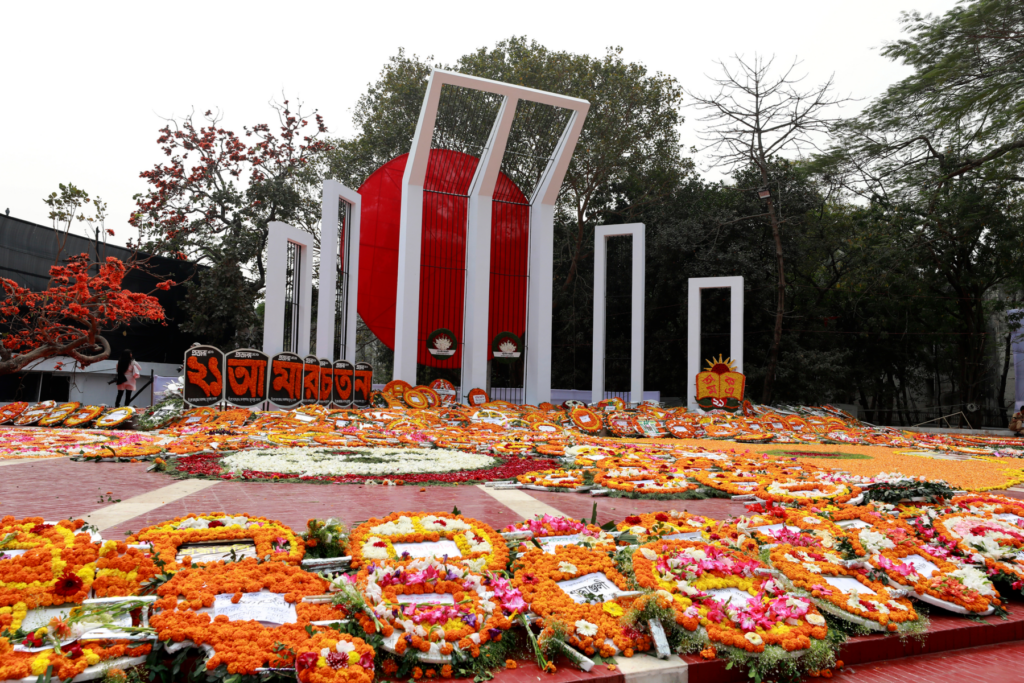
In collaboration with the Student Association of British Bangladeshis and the British Bangladeshi Poetry Collective, BGM held a poetry competition in honor of Ekushe February, which is known as International Mother Language Day. We opened this competition to highlight the talent of British Bangladeshi poets, since they are often underrepresented in the publishing sphere, and to showcase the rich history of poetic language in their diaspora. On behalf of all the organizations involved, BGM is pleased to announce the winner of our Ekushe February Competition, Tasmia Tahia for her poem “Dendrochronology.”
[Read Related: Celebrating International Mother Language Day and Multilingualism]
The journey of “Dendrochronology” started as a pair of words: Roots and Routes. Growing up as a British Bangladeshi, these words represented the tug of war between versions of me: from dressing up in red and white sarees to attend Boishakhi mela parades to hiding faint alta circles on my hands that I didn’t quite know how to explain to my friends.
Truths followed roots, then fruits, leading me to mangoes, mangroves and man grows. Lists were a staple of my childhood. My parents made me write out shopping lists in Bengali to nurture our mother tongue, opening me to historic and contemporary Bengali experiences through classic literature and poetry. This even culminated in a 400 marks (100%) result in my Bengali GCSE.
[Read Related: Celebrating International Mother Language Day with Self Reflection and Reclaiming One’s Bangladeshi Identity]
A narrative emerged from this scattering of interlinked words: a past of homogenous identities and shared struggles, a fractured present with jagged edges that refuse to fit in neat mosaics. Messy, mirrorless experiences birthed us, the generation who learnt to be both British and Bangladeshi. We told stories with every inch of being with costumes and customs to laughter and language.
Scientifically, dendrochronology is the method of dating rings inside tree trunks to exact years of formation. It is used to study historic climate and environmental conditions. When I visited the Natural History Museum as a child, I wondered if I too was made of layers of generational history. At Altab Ali Park, facing the replica Shaheed Minar in East London, I once heard a community elder say:
“We can’t speak English like you, because the time we should have spent learning was spent fighting so you didn’t have to.”
In learning to be comfortable in the patchwork of our forefathers’ experiences and quilting it with my multi-lingual threads, I honour their struggles and sacrifices, whether they’re the language martyrs of 1952 or the freedom fighters and war heroines of 1971. Sacred inheritance is not just memories but the duty of a legacy that grows evermore.
Dendrochronology
Generations of my elders
Stood shoulder to shoulder
In the knots of dark mangrove
Where man grows, from tangled
Roots, undistinguished,
Etching routes through tumultuous seas,
Or slicing through clouds in one leap,
My ancestors built
With every laboured breath
New truths, for them and for me.
Yet, on this sandy bank,
In a concrete maze, I stand
Cradling memories unknown
Of tangy green mangoes
Slice me open and see it plain
History of joy, wrapped in pain
Sacred inheritance, passed
Tongue to tongue,
Womb to womb
In new lands, bearing fruit
Retelling stories, ever more.




